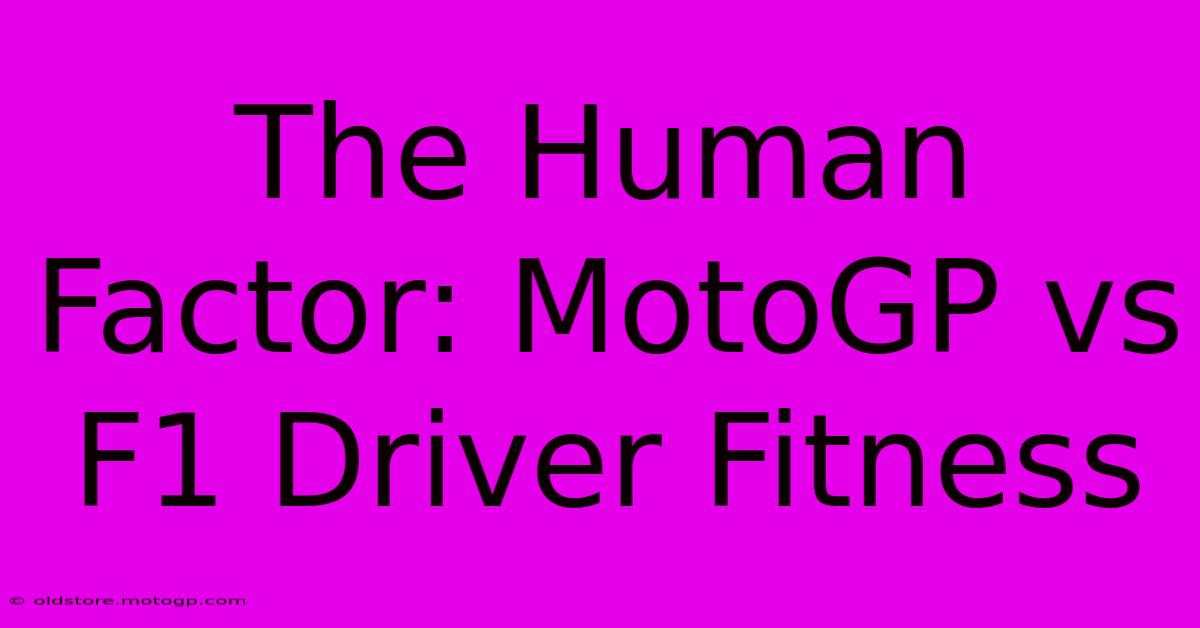The Human Factor: MotoGP Vs F1 Driver Fitness

Table of Contents
The Human Factor: MotoGP vs F1 Driver Fitness
The roar of the engines, the adrenaline rush, the nail-biting finishes – Formula 1 and MotoGP are pinnacles of motorsport, demanding the absolute peak of human performance. But while both require exceptional skill and precision, the physical demands placed on the drivers differ significantly. This article delves into the contrasting fitness regimes of MotoGP and F1 drivers, exploring the unique challenges each faces.
The G-Force Gauntlet: Different Demands, Different Training
The fundamental difference lies in the forces experienced. F1 drivers endure significant G-forces during cornering, particularly at high-speed tracks. These forces compress the body, demanding exceptional neck strength to maintain visual acuity and prevent blackouts. Their training focuses heavily on strength and conditioning, with an emphasis on core strength, neck training, and cardiovascular fitness. Think gym sessions, specialized neck exercises, and intense endurance work.
MotoGP riders, on the other hand, face a completely different set of physical challenges. While they also experience G-forces, the nature of motorcycle racing introduces extreme levels of vibration, constant changes in body position, and significant upper body strength demands required to wrestle powerful bikes around a track. Their fitness regimen leans towards agility, endurance, flexibility, and upper body strength, with training incorporating activities like motocross, cycling, and specialized core work designed to counteract the vibrations and maintain stability on the bike.
Cardiovascular Endurance: A Shared Necessity
Despite the variations, both F1 and MotoGP drivers require exceptional cardiovascular endurance. The intense concentration and physical exertion throughout races necessitates a high level of stamina. This is achieved through rigorous cardio workouts such as running, cycling, and swimming, forming a core element of both driver's training routines.
Mental Fortitude: The Unsung Champion
Beyond the physical demands, both disciplines demand exceptional mental fortitude. The pressure of competition, the risk of injury, and the need for split-second decision-making require immense mental resilience. Mental training techniques, including meditation, visualization, and psychological coaching, play a crucial role in ensuring drivers can perform under extreme pressure. This aspect is often overlooked but forms an integral part of their overall fitness.
Nutrition and Recovery: Fueling the Machine
Nutrition is another critical component. Both F1 and MotoGP drivers follow strict dietary plans to optimize their performance and recovery. Maintaining hydration, consuming the right amount of carbohydrates, protein, and fats, and ensuring adequate sleep are paramount to their success. Recovery methods, including ice baths, physiotherapy, and massage, are also crucial for minimizing muscle soreness and optimizing performance for the next event.
The Future of Driver Fitness: Technology's Influence
The ongoing development of technology influences driver fitness. Data analysis plays a crucial role in identifying areas for improvement in both training regimes. Sensors embedded in racing suits and cars provide valuable insights into physiological responses during racing, allowing for personalized training programs to be developed. This data-driven approach to fitness is revolutionizing how drivers prepare for the rigors of competition.
Conclusion: A Tale of Two Fitness Regimes
In conclusion, while both F1 and MotoGP drivers demand peak physical and mental fitness, their training approaches differ significantly. F1 drivers prioritize strength and neck endurance, while MotoGP riders focus on agility, upper body strength, and resilience to vibrations. However, both share a common need for exceptional cardiovascular endurance, mental fortitude, and a meticulous approach to nutrition and recovery. As technology continues to advance, we can expect to see further evolution in driver fitness regimes, pushing the boundaries of human performance even further.

Thank you for visiting our website wich cover about The Human Factor: MotoGP Vs F1 Driver Fitness. We hope the information provided has been useful to you. Feel free to contact us if you have any questions or need further assistance. See you next time and dont miss to bookmark.
Featured Posts
-
F1 Parking Your Gateway To The Grand Prix
Feb 24, 2025
-
The Definitive Guide To Austin F1 Transportation
Feb 24, 2025
-
Motorcycle Race Bikes For Sale Built For The Track
Feb 24, 2025
-
Circuit Of The Americas The Ultimate Racing Playground
Feb 24, 2025
-
Moto 2 Specs The Science Of Speed
Feb 24, 2025
